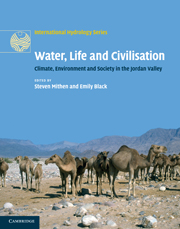Book contents
- Frontmatter
- Contents
- List of figures
- List of tables
- List of contributors
- Acknowledgements
- 1 Introduction: an interdisciplinary approach to Water, Life and Civilisation
- Part I Past, present and future climate
- Part II The palaeoenvironmental record
- Part III Hydrological studies of the Jordan Valley
- Part IV Human settlement, climate change, hydrology and water management
- Part V Palaeoeconomies and developing archaeological methodologies
- Part VI Society, economy and water today
- 24 Current water demands and future strategies under changing climatic conditions
- 25 Water reuse for irrigated agriculture in Jordan: soil sustainability, perceptions and management
- 26 Social equity issues and water supply under conditions of ‘water stress’: a study of low- and high-income households in Greater Amman, Jordan
- 27 The role of water and land management policies in contemporary socio-economic development in Wadi Faynan
- 28 Political discourses and public narratives on water supply issues in Amman, Jordan
- Part VII Conclusions
- Index
- Plate section
- References
27 - The role of water and land management policies in contemporary socio-economic development in Wadi Faynan
from Part VI - Society, economy and water today
Published online by Cambridge University Press: 26 April 2011
- Frontmatter
- Contents
- List of figures
- List of tables
- List of contributors
- Acknowledgements
- 1 Introduction: an interdisciplinary approach to Water, Life and Civilisation
- Part I Past, present and future climate
- Part II The palaeoenvironmental record
- Part III Hydrological studies of the Jordan Valley
- Part IV Human settlement, climate change, hydrology and water management
- Part V Palaeoeconomies and developing archaeological methodologies
- Part VI Society, economy and water today
- 24 Current water demands and future strategies under changing climatic conditions
- 25 Water reuse for irrigated agriculture in Jordan: soil sustainability, perceptions and management
- 26 Social equity issues and water supply under conditions of ‘water stress’: a study of low- and high-income households in Greater Amman, Jordan
- 27 The role of water and land management policies in contemporary socio-economic development in Wadi Faynan
- 28 Political discourses and public narratives on water supply issues in Amman, Jordan
- Part VII Conclusions
- Index
- Plate section
- References
Summary
ABSTRACT
The role of water and land management practices in promoting current development in the Wadi Faynan area, located in southern Jordan, forms the focus of this chapter. The area represents one of the most arid landscapes in Jordan and, until recently, was primarily used by semi-nomadic Bedouin tribes for winter grazing. Since 1921, the Government of Jordan has encouraged settlement and this transition has led to considerable changes in the day-to-day lives of the Bedouin, including the recent development of irrigated agriculture making use of shallow groundwater sources. The account considers the physical and social contexts of Wadi Faynan before turning to the cooperative model being used in the area to promote this irrigated agricultural activity. The characteristics of the irrigated agricultural system being used to produce tomatoes and watermelons are then outlined and reviewed, including recourse to specific farmer-based case studies. In conclusion, the impacts of the cooperative-led irrigated agricultural activity on reducing poverty in the areas are assessed, along with the need for wider imperatives at the sub-regional scale of southern Jordan, as a part of decentralisation from the national core centred on Greater Amman.
- Type
- Chapter
- Information
- Water, Life and CivilisationClimate, Environment and Society in the Jordan Valley, pp. 442 - 454Publisher: Cambridge University PressPrint publication year: 2011



